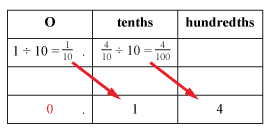![]()
Dividing decimal numbers by 10, 100 or 1000
Dividing decimal numbers by 10, 100 or 1000 follows the same procedure used for dividing whole numbers by 10, 100 or 1000.
1.4 ÷ 10:
14 ÷ 10 = 1.4
1.4 ÷ 100:
We place zeroes in the spaces to say that there are 'no tenths' and 'no ones'.
1.4 ÷ 100 = 0.014
You might have noticed another shortcut:
When you divide a decimal by ten, the decimal point moves one place to the left.

When you divide a decimal by 100, the decimal point moves two places to the left.

When you divide a decimal by 1000, the decimal point moves three places to the left and you fill the new tenths place with a zero to say that there are 'no tenths'.







